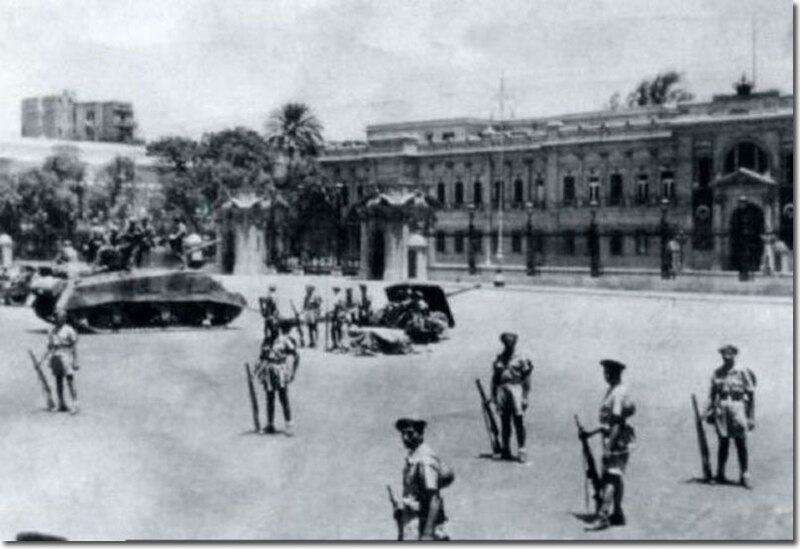File:Abdeenpalace.jpg

Original file (808 × 554 pixels, file size: 87 KB, MIME type: image/jpeg)
Captions
Captions
Summary
[edit]| DescriptionAbdeenpalace.jpg |
English: Following a ministerial crisis in February 1942, the British government, through its ambassador in Egypt, Sir Miles Lampson, pressed Farouk to have a Wafd or Wafd-coalition government replace Hussein Sirri Pasha's government. This reversal of long-standing opposition to the Wafd came from the British belief that the Wafd, still the most popular of the Egyptian political parties, would be more effective in gaining public support in Egypt for the British war effort than any of the other parties. It was also hoped that a Wafd government would weaken the influence of the pro-Axis elements around King Farouk. Lampson eventually decided to force this choice on Farouk by insisting that he abdicate unless he agreed to ask the Wafd leader, Mustafa el-Nahhas, to form a government. Lampson sought and finally gained the support of Oliver Lyttleton in the British cabinet to apply pressure on the Egyptian King.
On the night of 4 February 1942, General Stone surrounded Abdeen Palace in Cairo with troops and tanks, and Lampson presented Farouk with an abdication decree drafted by Sir Walter Monckton. Farouk capitulated, and Nahhas formed a government shortly thereafter. However, the humiliation meted out to Farouk and the actions of the Wafd in cooperating with the British and taking power, lost support for both the British and the Wafd among both civilians and, more importantly, the Egyptian military. |
| Date | |
| Source | https://www.britishempire.co.uk/maproom/abdeenpalace.htm |
| Author | Unknown |
Licensing
[edit]==
| Public domainPublic domainfalsefalse |
This Egyptian work is currently in the public domain in Egypt because its copyright has expired pursuant to the provisions of Intellectual Property Law 82 of 2002. The 2002 law, which repealed Copyright Law 354 of 1954, was not retroactive, meaning that works which had fallen into the public domain in 2002 remain out-of-copyright in Egypt (details).
In order to be hosted on Commons, all works must be in the public domain in the United States as well as in their source country. Egyptian works that are currently in the public domain in the United States are those whose copyright had expired in Egypt on the U.S. date of restoration (January 1, 1996) pursuant to the provisions of the old 1954 law which was in effect at the time.
العربية ∙ Deutsch ∙ English ∙ français ∙ 日本語 ∙ русский ∙ +/−
|

| |||||||||||||||||||||||
File history
Click on a date/time to view the file as it appeared at that time.
| Date/Time | Thumbnail | Dimensions | User | Comment | |
|---|---|---|---|---|---|
| current | 04:05, 17 October 2023 |  | 808 × 554 (87 KB) | Drsmartypants(Smarty M.D) (talk | contribs) | Uploaded a work by Unknown from https://www.britishempire.co.uk/maproom/abdeenpalace.htm with UploadWizard |
You cannot overwrite this file.
File usage on Commons
There are no pages that use this file.
File usage on other wikis
The following other wikis use this file:
- Usage on en.wikipedia.org
Metadata
This file contains additional information such as Exif metadata which may have been added by the digital camera, scanner, or software program used to create or digitize it. If the file has been modified from its original state, some details such as the timestamp may not fully reflect those of the original file. The timestamp is only as accurate as the clock in the camera, and it may be completely wrong.
| Orientation | Normal |
|---|---|
| Horizontal resolution | 96 dpi |
| Vertical resolution | 96 dpi |
| Software used | Adobe Photoshop CS3 Macintosh |
| File change date and time | 17:09, 24 April 2017 |
| Color space | Uncalibrated |
| Image width | 808 px |
| Image height | 554 px |
| Date and time of digitizing | 18:09, 24 April 2017 |
| Date metadata was last modified | 18:09, 24 April 2017 |
| IIM version | 24,946 |